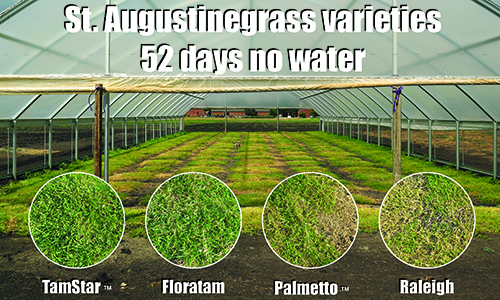Hybrid St. Augustinegrass lines bred using embryo rescue technique by researchers at the Texas A&M AgriLife Research and Extension Center of Dallas continue to undergo evaluation for water resource efficiency and drought tolerance. The evaluation process represents a joint effort between the Dallas Center researchers and the Turfgrass Producers of Texas.
Breeding lines identified as drought tolerant and water efficient are now being tested for the effectiveness of those traits compared with St. Augustinegrass varieties on the market now.
“These lines have been selected for their good drought potential and are entering evaluation under the assumption that will out perform existing varieties,” said the Dallas Center’s lead turf breeding scientist Dr. Ambika Chandra. “We are looking at the amount of water it takes to keep a variety above 50 percent green cover.”
The study began in 2014 with 2015 and 2016 serving as a time for data collection. Once roots were established, irrigation systems were shut off to simulate drought by using an outdoor shelter environment. Researchers analyze the hybrids’ progress weekly through digital imaging – an effort to find the most sustainable St. Augustinegrass varieties for urban use across the southern United States.
Embryo Rescue Technique
Texas A&M AgriLife Research’s Dallas Turf Breeding program is the pioneer of embryo rescue technique in breeding St. Augustine turfgrass varieties. The technique, which has been used in many crops, allows the breeding team to combine traits like drought, heat tolerance and insect resistance with strong aesthetic quality. The technique involves isolating hybrid embryos from the maternal plant 21 days after pollination and sustaining their growth on tissue culture medium. Turfgrass lines bred at the Dallas Center through embryo rescue technique have shown extraordinary potential for combining drought tolerance and aesthetic appeal.
Contact Dr. Ambika Chandra for information.
[email protected]

